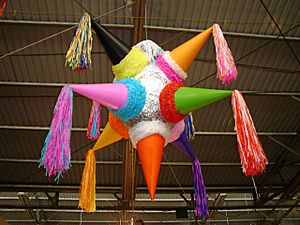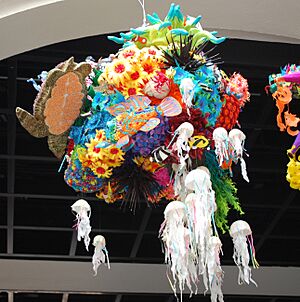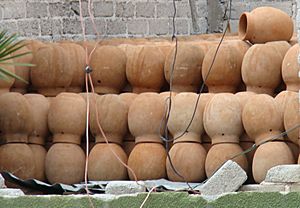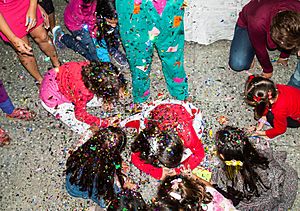Piñata facts for kids
A piñata is a fun container, often made from papier-mâché, clay, or cloth. It's decorated and filled with candy, then broken open during a celebration. Piñatas are very popular in Mexico.
The idea of breaking a container full of treats came to Europe in the 1300s. Spanish people then brought this tradition to Mexico. However, similar traditions already existed in Mesoamerica, like the Aztecs honoring their god Huītzilōpōchtli in mid-December.
Records show that the Mexican piñata tradition started in Acolman, a town near Mexico City. Here, piñatas were used to teach religious lessons and to blend with the local celebrations. Today, piñatas are still a big part of Mexican culture and other countries in Latin America, as well as the United States. They have mostly become a fun party game, losing their old religious meaning.
Contents
What is a Piñata?
The word "piñata" comes from the Spanish word piñata. It likely comes from the Italian word pignatta, which means 'fragile pot'. This Italian word might be linked to pigna, meaning 'pinecone'.
The History of Piñatas
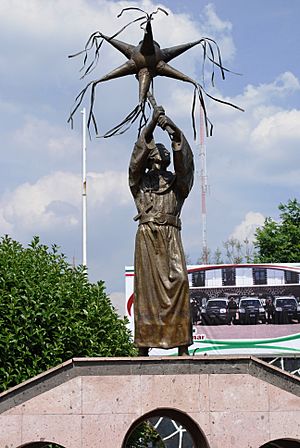
Today, piñatas are mostly for fun parties, but they have a long history. Many believe they first came from China. The Chinese used a piñata shaped like a cow or ox for their Chinese New Year celebrations. It was decorated with symbols and colors to bring good weather for farming. It was filled with five types of seeds and hit with colorful sticks. After it broke, the pieces were burned, and the ashes were kept for good luck.
This tradition reached Europe in the 1300s. There, it became linked to the Christian celebration of Lent. In Spain, the first Sunday of Lent was even called "Piñata Sunday." At first, the Spanish used plain clay pots. Later, they started decorating them with ribbons and colorful paper.
The European piñata tradition arrived in Mexico in the 1500s. But, as mentioned, a similar game already existed in Mesoamerica. The Mayans had a game much like modern piñatas, where players were blindfolded. The Aztecs celebrated the birthday of Huitzilopochtli by decorating a clay pot with colorful feathers. When the pot was broken, the treasures inside fell as an offering to their god.
In 1586, Augustinian monks in Acolman, Mexico, started using piñatas to teach about Christianity. They changed European piñatas and created the Las Posadas tradition. This helped blend the local celebration of Huitzilopochtli's birth with Christian teachings.
Piñatas and Their Meanings
The Mexican Catholic tradition gave piñatas special meanings. The seven points on a star-shaped piñata were said to represent the seven deadly sins. The pot itself stood for evil, and the treats inside were like the temptations of evil. The person hitting the piñata was blindfolded to show faith. The spinning and shouting represented how confusing temptation can be. When the piñata broke, the treats falling out were seen as the rewards for staying faithful.
Over time, the piñata has mostly lost its religious meaning. It is now popular for many types of celebrations, not just during December's Las Posadas. Clay pots have often been replaced by papier-mâché containers, which are safer. Making piñatas has even become an art form in some places. In Tepatitlán, Mexico, the world's largest traditional seven-pointed piñata was made in 2010. It was 11.2 meters (about 37 feet) tall!
Piñatas in Mexico Today
Piñatas are most strongly connected with Mexico. The art of making modern piñatas is part of a Mexican craft called "cartonería." This means making things from paper and cardboard. The Museo de Arte Popular even holds a contest for Mexican piñatas to help keep this tradition alive.
While the religious meaning is mostly gone, the way the game is played has stayed much the same. Piñatas are most popular during Las Posadas and for birthday parties. Each person, usually a child, takes a turn hitting the piñata. It hangs from a string above. The player is blindfolded, given a wooden stick, and spun around. As they try to hit the piñata, someone else moves it to make it harder. There's a time limit for each person's turn, marked by a traditional song.
Piñatas used to be made with a clay pot inside. Many artists still make and sell these pots for people to decorate. However, piñatas made from cardboard and papier-mâché are now more common. These are often shaped over balloons. One reason for this change is that broken clay pieces can be dangerous for children. Modern piñatas are decorated with crepe paper and come in all shapes and sizes. Many look like popular cartoon characters or heroes like Batman or Spider-Man. For Christmas, the traditional star shape with points is still popular, as it reminds people of the Star of Bethlehem.

In Mexico, especially at Christmas, piñatas are filled with fruits and candies. These include guavas, oranges, jicamas, sugar cane pieces, tejocotes, and wrapped candies. Some piñatas are "traps" filled with flour, confetti, or water! If a child doesn't get any treats after the piñata breaks, they might get a special basket of treats called colaciónes to prevent sad feelings.
Many towns in Mexico specialize in making piñatas. Acolman, where piñatas first started, holds an annual National Piñata Fair. This event has cultural activities, workshops on making piñatas, contests, and traditional Posadas. It can attract up to 100,000 visitors.
About 400 families in San Juan de la Puerta, Guanajuato, make about 16,000 piñatas every month. This craft supports about half the people in the town. Even prisoners in Huajuapan de León make piñatas to sell.
The busiest time for piñata sales in Mexico is December, for posadas.

The star shape is still popular for Christmas. But for other events, traditional shapes like donkeys have mostly been replaced by cartoon characters from U.S. movies and TV shows. However, many of these piñatas do not follow copyright laws. Companies like Marvel Comics have complained about this. Sometimes, authorities will take these piñatas from stores. Vendors say they have sold these for decades without problems. They also say it's hard to sell other types because customers prefer the popular characters. Mexico exports piñatas to the United States, but copyright issues can cause problems at the border.
Some piñatas in Mexico are made for adults. These might look like political figures, especially ones that people don't like very much.
Piñatas are also popular in many other Latin American countries.
Piñatas in the United States
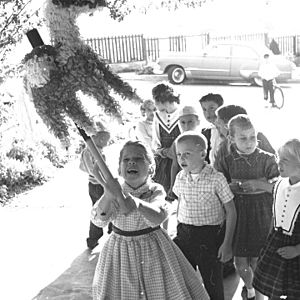
Piñatas have become popular in Mexican-American and other Hispanic communities in the United States. They are also used by many non-Hispanic people. They are used for birthday parties, Christmas, and Cinco de Mayo celebrations.
The 2006 video game Viva Piñata is about a world where piñatas try to be chosen for children's birthday parties. A TV show, also called Viva Piñata, was made to help sell the Xbox game.
Similar Traditions Around the World
Europe
In Denmark, there's a tradition called slå katten af tønden. This means "hit the cat out of the barrel." People hit a wooden barrel to release candy.
In Catalonia, a Christmas tradition is called "fer cagar el tió." A log is wrapped in a blanket and "fed" grass before Christmas. On Christmas Eve, people hit the log with sticks. Then, the blanket is removed to show gifts that the log has "given out."
In Italy, there were feasts with a game like a piñata, called pentolaccia. These were celebrated on the first Sunday of Lent.
Asia
In Maharashtra, India, a similar tradition called Dahi Handi happens during the festival of Janmashtami. This celebrates Lord Krishna's birthday. Clay pots filled with buttermilk, money, or treats are hung high up in public places. Teams form human pyramids to reach and break the pot.
In villages in South India, festivals have a competition called Uri adithal. This is "Pot breaking with blindfold" and is very much like the piñata game.
In Japan, a game called suikawari is played. In this game, a watermelon shell is used instead of a piñata.
In the Philippines, a game called hampas-palayok or pukpok-palayok (hit-the-pot) is played at parties. A clay pot filled with treats or prizes is used. Also, đập nêu (pot-hitting) is a traditional custom in Vietnam.
How to Make a Piñata
You can make a piñata using cardboard, paper mache, or even simple paper bags.
Cardboard Piñata
You'll need:
- Sturdy cardboard
- Empty cereal box (for sides)
- Tissue paper (various colors)
- Masking tape
- Scissors
- Glue stick
- Pipe cleaners or thick twine (for hanging)
First, cut two identical pieces of cardboard into your chosen shape, like a number or an animal. Cut strips from a cereal box to make the sides of the piñata. The width of these strips will decide how thick your piñata is. Use masking tape to join the cardboard pieces and cereal box strips. Remember to leave an opening at the top for filling. Cut tissue paper into 2-inch-wide strips and make fringes by snipping halfway up one side. Glue the fringed tissue paper onto the piñata, starting from the bottom and working your way up. Finally, make holes in the top flap for twine or pipe cleaners to hang your piñata.
Paper Mache Piñata
You'll need:
- Balloon
- Newspaper (cut into strips)
- Flour and water (for paste)
- Tissue paper (for decoration)
- Twine (for hanging)
- Candy for filling
Mix equal parts of flour and water to make a paste. Blow up a balloon to the size you want your piñata to be. Dip newspaper strips into the paste, squeeze off extra paste, and layer them over the balloon. Cover the balloon with 3-4 layers, leaving an opening at the top. Let it dry for at least 24 hours. Once it's dry, pop the balloon. Then, decorate your piñata with tissue paper as you like.
Quick Paper Bag Piñata
You'll need:
- Paper lunch bag
- Crepe streamers
- Glue stick
- Scissors
- Candy for filling
Fill a paper lunch bag with candy and seal it closed. Cut crepe streamers into different lengths. Glue them onto the bag, layering them as you go. Punch holes in the top of the bag and thread curling ribbon through to hang it.
See also
 In Spanish: Piñata para niños
In Spanish: Piñata para niños
- Piñata cookie
- Tió de Nadal
- Parol, a similar but separate tradition in the Philippines symbolizing the Star of Bethlehem


